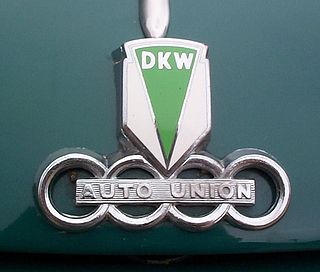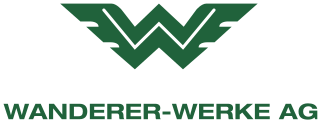
DKW was a German car and motorcycle marque. DKW was one of the four companies that formed Auto Union in 1932 and is hence an ancestor of the modern day Audi company.

Auto Union AG, Chemnitz, was an amalgamation of four German automobile manufacturers, founded in 1932 and established in 1936 in Chemnitz, Saxony. It is the immediate predecessor of Audi as it is known today.

Wanderer was a German manufacturer of bicycles, motorcycles, automobiles, vans and other machinery. Established as Winklhofer & Jaenicke in 1896 by Johann Baptist Winklhofer and Richard Adolf Jaenicke, the company used the Wanderer brand name from 1911, making civilian automobiles until 1941 and military vehicles until 1945.

Horch was a car brand manufacturer, founded in Germany by August Horch & Cie at the beginning of the 20th century.

The Fiat Fiorino is a small commercial vehicle produced by the Italian car manufacturer Fiat since 1977. Its first two generations have been the panel van derivatives of other small models, such as the Fiat 127 and Fiat Uno, while the current third generation was developed jointly with PSA Peugeot Citroën, and is based on the Fiat Small platform.
The Mercedes-Benz MB100 is a light commercial cabover van (M) made by Mercedes-Benz España S.A. from 1981 to 1996 at their Vitoria-Gasteiz factory in northern Spain. The third generation model was manufactured by SsangYong alongside the rebadged SsangYong version from 1995 to December 2003 in South Korea, with another rebadged variant manufactured by Maxus of SAIC Motor from 2009 to 2014 in China.

Sisu Auto is a truck manufacturer based in Raseborg, Finland. Its name comes from the Finnish word sisu meaning guts, grit and determination.

The DKW F102 is a passenger car that was produced from August 1963 by the German manufacturer Auto Union. Superseding the Auto Union 1000, it was the last model branded as a DKW by the manufacturer and also the last West German production car equipped with a two-stroke engine.

Tempo, was a German automobile manufacturer based in Hamburg. The company was founded by Oscar Vidal in 1924.

The Auto Union 1000 is a luxury compact front-wheel drive automobile manufactured by Auto Union GmbH between 1958 and 1965. It was the first model branded as an Auto Union by the manufacturer since the 1930s; it replaced the paradoxically named DKW 3=6, although the latter continued in production, reassuringly now branded as the DKW 900, for another year. The two cars were broadly similar, but the new car had its two-stroke engine enlarged to 981 cc yielding a 10% - 37% power increase.

The DKW Meisterklasse, also known as the DKW F89, is a compact front-wheel drive saloon manufactured by Auto Union GmbH between 1950 and 1954. It was the first passenger car to be manufactured by the new Auto Union company in West Germany following the re-establishment of the business in the west in 1949.

The DKW Junior was a small front wheel drive saloon manufactured by Auto Union AG. The car received a positive reaction when first exhibited, initially badged as the DKW 600, at the Frankfurt Motor Show in March 1957. The ‘Junior’ name was given to the DKW 750 in 1959 when the car went into volume production, but failed to survive an upgrade in January 1963, after which the car was known as the DKW F12. In addition to the saloon, a pretty ‘F12 Roadster’ was produced in limited numbers.

From 1931 to 1939, Daimler-Benz AG produced three cars with rear engine as well as a few prototypes. The production numbers remained quite low for each of these models, especially compared to the production of classical front-engine Mercedes cars.

The Lloyd LT 500 was a compact van produced and sold by the German automaker Borgward Groups's Lloyd Motoren Werke GmbH in Bremen, Germany between 1953 and 1957. A six seater minivan version was offered by April 1954.

The Wartburg 311 was a car produced by East German car manufacturer VEB Automobilwerk Eisenach from 1956 to 1965. The 311 model was manufactured in a number of variations, including pickup, sedan, limousine, coupé, and as a two-seat roadster. The two-stroke engine was enlarged to 992 cc in 1962. An interim model, called the Wartburg 312 and featuring the chassis developed for the succeeding 353, was built from 1965 until 1967.

Industrias Aeronáuticas y Mecánicas del Estado was a State-owned entity and autarchic conglomerate of factories of Argentina created in 1951 to promote the manufacture of aircraft and automobiles.

The Institec Justicialista was a line of cars produced by the government of Argentina via IAME from 1954 to 1955 as an attempt to develop a native Argentine automotive industry. It used a front-engine, front-wheel-drive layout with a two-stroke two-cylinder engine derived from a German DKW design and a conventional metal body. Due to the insistence of General Juan Domingo Perón a sports car prototype was made, a two-seat version was showcase as roadster in the Paris Motor Show. The prototype was repurpose Porsche with a fiberglass body powered by a 1.5-liter air-cooled Porsche flat-four engine and a Porsche four-speed gearbox driving the front wheels.
FAW Jilin (一汽吉林) is a subsidiary of the First Automobile Works and a maker of mini vehicles, small trucks and vans that see commercial use. It is located in Jilin City, Jilin province, China.
Industria Argentina de Vehículos de Avanzada was an automotive company created in 1971 by 16 owners of Argentine Fiat dealerships. Headquartered in Martínez, Buenos Aires, IAVA was the first manufacturer of performance vehicles in Argentina, being a subsidiary of Fiat Concord and then Sevel Argentina until it was closed in 1985.

The Mercedes-Benz N1300 is a light commercial vehicle designed and manufactured by the Spanish subsidiary IMOSA based in Vitoria-Gasteiz, in the Basque Country, north of Spain. Its body had its roots in the Fissore-designed DKW F1000 L van of 1963.



















